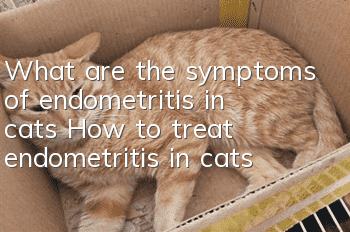What are the symptoms of endometritis in cats? How to treat endometritis in cats

Endometritis is a genital disease, which is also one of the main diseases that cause infertility in cats. It is more common in female cats in estrus. The cause of the disease may be bacterial infection during breeding, or during childbirth. Secondary infections occurred after the pups were born. In addition, dystocia, stillbirth, fetal corruption, birth canal damage and poor disinfection during midwifery can also lead to the occurrence of this disease.
Symptoms of endometritis in female cats
1. Acute feline endometritis: The first symptoms appear within 12 hours to 4 days after delivery. Sick cats are depressed, anorexic, have body temperatures above 39.5°C, pulse frequency, decreased lactation or refuse to breastfeed, and some are accompanied by mastitis, arched back, strenuousness, and thin, foul-smelling, red vaginal discharge. Membrane retention is green or black). If there is a large amount of mucous membrane in the discharge, it is a symptom of poisoning. Often there will be convulsions, high mental depression, and frequent licking of the labia. A flaccid uterus can be felt on abdominal palpation, but palpation is refused due to pain in secondary peritonitis. Laboratory tests showed that the number of white blood cells increased significantly or decreased significantly. When the number of white blood cells increases, most of them are accompanied by leftward shift of the nucleus.
2. Chronic catarrhal feline endometritis: normal sexual cycle, but infertility with repeated ovulations; turbid and flocculent mucus often flows out from the vulva, often mixed with blood. The vaginal mucosa is congested and the cervix is open.
3. Chronic suppurative endometritis: sexual cycle disorder, mucus-purulent exudate flowing out from the vulva, mixed with blood; uterine volume increases on abdominal palpation, with a sense of fluctuation; vaginal mucosa and cervical edema and severe congestion.
Treatment of cat endometritis
1. Systemic treatment: Do a drug sensitivity test first, then use selected antibiotics for systemic treatment, and continue to use them for at least 3-4 days after the body temperature drops to normal.
Intravenous fluid rehydration to prevent dehydration, detoxification and correct electrolyte balance disorders.
2. For open purulent endometritis, the uterus can be flushed with 0.1% Reifonol solution, and selected antibiotics can be injected into it after flushing. Whether douched or not, intrauterine antibiotics (preferably combined with estrogen) are beneficial in preventing the spread of infection.
3. Promote uterine contraction and discharge of uterine contents. For this purpose, 0.5-1.5 ml of 1% artificial estrogen can be intramuscularly injected, or 5-10 units of oxytocin can be intramuscularly injected, or ergometrine can be administered by gavage at a dose of 0.2 mg (3 times a day for 2-3 days). In addition, massaging the uterus through the abdominal wall also has a certain effect.
Note: In cases of extreme uterine expansion, uterine contraction drugs are prohibited, otherwise it may lead to uterine rupture or peritonitis.
- A cat will die if it urinates for a few days
- Should you deworm yourself or go to a pet store?
- Are cat teasers harmful to cats?
- What should I do if my cat suffers from chronic gingivitis?
- Cat's nails are cracked with a thin layer
- Cats go crazy after eating mutton
- What does cat moss on a cat’s chin look like?
- Can cats reproduce after abdominal transmission is cured?
- What exactly is the sterilization shot for female cats?
- Can I still eat unopened cat food if it has expired?



